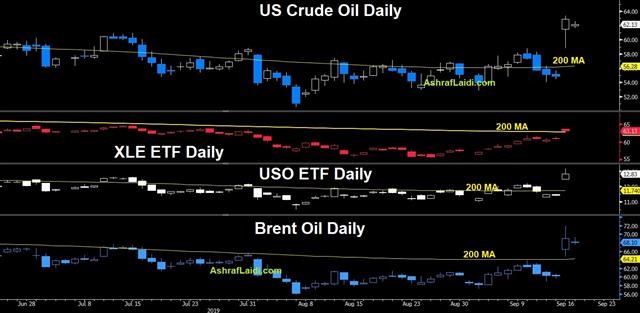The spike in crude oil following the attack on Saudi production facilities adds a wind car to the FOMC decision later today, reports Adam Button.
The latest rise in oil prices may jeopardize the already complicated balancing act at the Federal Reserve (between containing manufacturing deterioration from the trade war) and Trump's managing of Saudi Arabia and Iran without provoking further price ascent. Yet, the U.S. Administration continues to send signals about reprisals against Iran and that helped crude to its fourth best day on record Monday. U.S. crude oil traded up to $63.38 on Monday (Brent to $71.95) before receding at the end of the day and dropping further on Tuesday as tempers lowered.
The Canadian dollar (CAD) loses half of its gains as U.S. equity futures head into the red. The euro is the strongest of the day after better than expected ZEW sentiment survey.

Crude oil finished Monday with an astounding $8 rally in the largest percentage climb since 2009 and fourth highest on record. The attack on Iran sets in motion a wild amount of possibilities, including war between Iran and Saudi Arabia.
Trump's response has pointed the finger at Iran but stopped short of anything definitive. So far in his Presidency, he has largely ignored the drums of war and his firing of John Bolton underscored that just a week ago.
This time, he's hinting that action may be in order but his tepid response so far suggests it may be limited. That may mean a further escalation down the line but if so, the market will revert to a focus on fundamentals and the ability of Saudi Aramco to bring production back online. On that front, reports vary widely with some suggesting nearly all of it could be restored in two weeks while others say it could be months.
Oil Complicates Fed Odds
Expect oil headlines to be a major factor in the days ahead but the Fed remains a key input. The odds of a cut fell to 95% from 100% a week ago. The oil jump complicates the decision because it creates a series of pros and cons. Higher gasoline prices for consumers and geopolitical uncertainty are negatives, but higher inflation and more investment/profits from U.S. oil firms are positives. Ultimately, it's more of a reason to cut 25 basis points as anticipated while sticking with a wait-and-see statement and message. There is ambiguity to the recent geopolitical inputs, which could allow Powell to do what he thinks is prudent—rather than appease the demands of the Administration. Also, pay attention to the dissent and whether St Louis Fed president Bullard shall stick to his position of demanding a 50-basis point rate cut after the oil spike.
Adam Button is co-owner and managing director of ForexLive.com and a contributor at AshrafLaidi.com. You can see Ashraf’s daily analysis at www.AshrafLaidi.com and sign up for the Premium Insights. Ashraf's Tweet on indices here.





















